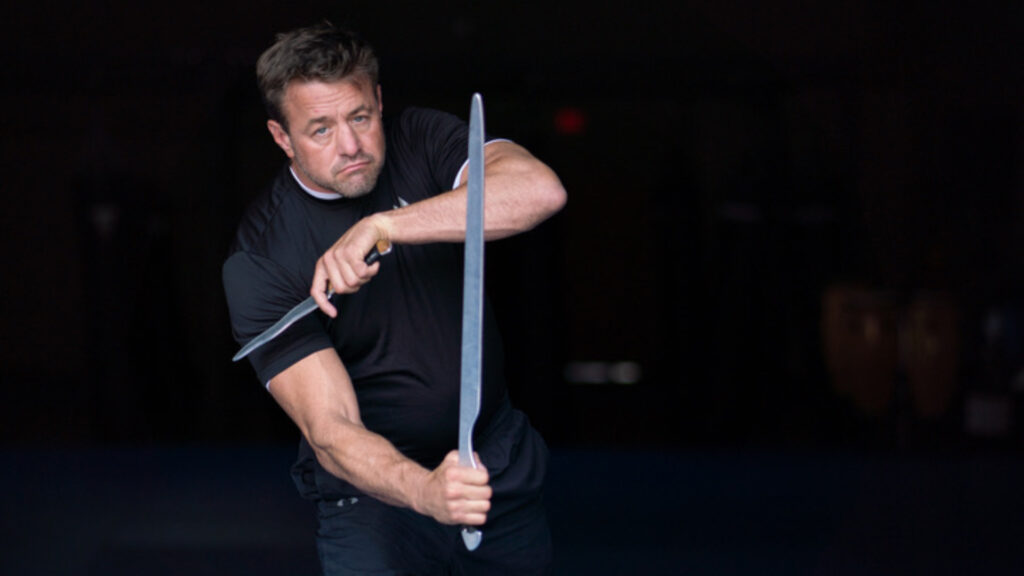
Throughout history, the sword has served not just as a weapon but as a profound tool for both physical and mental development. Beyond its practical use in combat, the sword has been an instrument of personal growth, teaching discipline, focus, and ethical conduct across various cultures. It symbolizes power and commands respect, often representing justice, authority, and nobility. As a result, mastery of the sword involves cultivating virtues that extend beyond the battlefield, shaping individuals into leaders and revered figures in their communities.
Here are some notable examples:
- European Knights and Samurai of Japan: Both used the sword as a weapon and a spiritual and moral symbol, embodying honor, discipline, and the warrior ethos.
- Ancient Rome: Gladiators trained with swords to enhance both their physical prowess and mental sharpness, entertaining and serving a social role in Roman culture.
- Chinese Martial Arts: Swords like the Jian, a double-edged straight sword, have been central to martial arts training, emphasizing balance, coordination, and the philosophical aspects of Taoism.
- Renaissance Europe: The rapier became popular not just for defense but as a part of a gentleman’s education in the arts of dance, etiquette, and combat, reflecting the values of grace and poise.
- Persian Empire: The scimitar was a key symbol of power and authority. Persian warriors used it not only for battle but also in ceremonial contexts, reflecting mastery and prestige.
- The Vikings: Known for their Ulfberht swords, Vikings regarded swordsmanship as essential to their culture, embodying strength, bravery, and the heroic ideals of Norse mythology.
- Indian Warriors: In India, the talwar, a type of curved sword, was prominent among Rajput warriors, who were esteemed for their martial skills and strict adherence to the warrior code of honor, known as Kshatriya.
- Filipino Mandirigma: In the Philippines, the practice of Kali, also known as Eskrima or Arnis, represents a significant aspect of the warrior culture. This martial art, which prominently features sword fighting alongside sticks and other bladed weapons, is deeply integrated into Filipino history and identity. It emphasizes speed, agility, and strategic thinking, reflecting the Filipino ethos of resourcefulness and adaptability. Kali has not only been a method of self-defense but also a way of instilling discipline, respect, and a sense of community among practitioners.
- Burmese Gurkhas: In Burma, the Gurkhas are renowned for their use of the Kukri, a distinctive curved sword that is both a weapon and a symbol of courage. Skilled in its use, Gurkhas have a storied history as fearsome warriors and loyal soldiers. The Kukri is not just a tool of warfare; it also holds a cultural significance, representing the bravery and valor of the Gurkhas. The training and discipline involved in mastering the Kukri imbue these warriors with a profound sense of duty and honor, essential elements of their warrior ethos.
These examples illustrate how the sword has shaped cultures and individuals, emphasizing a blend of physical skill and deeper philosophical teachings.
Throughout my martial arts career, the sword and other bladed weapons have not only been central to the physical aspect of training but have also served as profound symbols of growth, honor, and the warrior spirit. These weapons represent more than tools of combat; they embody the virtues we aspire to both on the battlefield and in life. My journey through various disciplines, such as Burmese Bando with its iconic Kukri, Filipino martial arts with its diverse array of blades, the broadsword from Shaolin Kung Fu, and the butterfly sword of Wing Chun, has deepened my understanding of this symbolism. Taught by numerous instructors, this ethos of honor and respect was consistently upheld across all forms of martial arts, reinforcing the deep-seated cultural and ethical significance these weapons hold.
Unfortunately, students or end users often aren’t informed that elements of traditional martial arts have been omitted from their training. They are typically taught the art as it currently stands and assured that it will protect them against aggressors. However, this training does not always introduce them to higher levels of violence or aggression that may be necessary to counter a determined predator effectively. For example, attempting to apply a choke or an armbar on an attacker resolved to inflict lethal harm can prove inadequate. Many believe they are employing the most extreme measures taught to them, not realizing their martial arts system may have excluded crucial techniques involving handheld weapons, which represent a more severe level of violence. This oversight can be a serious disservice.
Initially, most “War Arts” (Martial Arts) were centered around the training and study of weaponry, with the blade, the sword, being a common focus. However, over time, an interesting transition occurred. The study of weaponry was gradually phased out, giving way to a new focus-the development of what is now commonly known as empty-hand studies. This is unfortunate because it starts to remove the “war” from the study, and it solely starts to focus on the “defensive” application of the information.
I understand the importance of a practitioner being proficient in varying degrees of force, especially in contexts requiring lower aggression. This often applies in social settings influenced by societal norms and local laws, where excessive force can be inappropriate or illegal. Therefore, it’s crucial for practitioners to be capable of modulating their level of force to adapt to a defensive mindset suitable for these environments.
Unfortunately, students or end users often aren’t informed that elements of traditional martial arts have been omitted from their training. They are typically taught the art as it currently stands and assured that it will protect them against aggressors. However, this training does not always introduce them to higher levels of violence or aggression that may be necessary to counter a determined predator effectively. For example, attempting to apply a choke or an armbar on an attacker resolved to inflict lethal harm can prove inadequate. Many believe they are employing the most extreme measures taught to them, not realizing their martial arts system may have excluded crucial techniques involving handheld weapons, which represent a more severe level of violence. This oversight can be a serious disservice.
If your training excludes firearms, edged weaponry, and blunt weapons, you are missing crucial components historically used to combat aggressive predators. Should your current training lack these elements, seeking a competent instructor or resource to address these gaps is critical. If necessary, take the initiative to incorporate these tools yourself. This is why I employ what I call The Combat Blueprint from the C-Tac Program, designed to identify and rectify deficiencies in your training. The Combat Blueprint not only highlights knowledge gaps but also pinpoints the most primal environments essential for comprehensive study.
It’s time to reintroduce the sword into our combat studies. Emphasizing a powerful offense can be more effective than merely defending against an attack; indeed, there is a significant difference between simply defending and actively countering an attack. I advocate for the latter approach. Moreover, the traditional study of the sword was accompanied by a robust warrior’s code, a fundamental code of ethics, and the principles of chivalry, which are lost arts today. Reinstating these old-school values could greatly benefit society, reviving a sense of honor, discipline, and respect visibly lacking in today’s cultural landscape. These principles enhance martial skills and foster a resilient, principled warrior mindset crucial for personal development and societal improvement.
Throughout history, the sword has been a physical tool and a profound catalyst for mental and spiritual growth, embodying principles of discipline, honor, and ethics. As we explore various cultures, from European knights to Filipino Mandirigma, the theme is consistent: the sword is more than a weapon; it’s a key to understanding and cultivating deeper virtues. Today, reintroducing these comprehensive studies in weaponry, including the disciplined and ethical frameworks accompanying traditional sword training, could revitalize lost wisdom and enhance both individual and societal fortitude. It’s time to reforge our connection to these ancient disciplines, recognizing the sword’s role in combat and as a vital instrument of personal and community development.
Shift Your Perspective, Take the Action, Transform Your World.
~ Sifu Alan

Alan Baker is renowned for his dual expertise in crafting tailored Defensive Tactics Programs and high-performance coaching. Catering specifically to law enforcement agencies, military organizations, and security firms, Alan designs training regimens that emphasize practical techniques, real-world adaptability, and scenario-based training. His approach enhances the capabilities and readiness of personnel in intense situations. Explore Alan’s tailored programs here.
Beyond mere tactics, Alan stands out as the paramount “mindset” coach, adept at unlocking the vast potential within individuals. With a deep passion for mentoring professionals, entrepreneurs, and those on personal growth odysseys, he focuses on nurturing a mindset of excellence. Alan’s coaching hinges on practical strategies that bolster mental resilience, focus, and drive. Teaming up with Alan means embarking on a transformative path where mental barriers are dismantled, inherent strengths come to the fore, and your goals become within clear sight. His profound insights enhance performance and sculpt a mindset tailored for triumphant success.
To delve deeper into Alan’s mindset philosophy, peruse his enlightening collection of books And if you’re ready to amplify your journey under Alan’s tutelage, connect through his official website.

